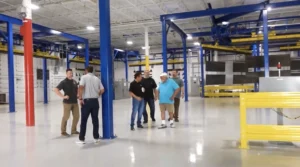How 3D-Printing Is Solving Real World Problems From the Ground Up
It is no secret that a 3D-printing revolution is close at hand. With applications in countless industries and production costs dropping on an almost weekly basis, 3D-printing is poised to help tackle two of the globe’s most pressing modern problems: the energy and housing crises. Transnational tech firms are racing to demonstrate their innovations and bring in the investments needed to get into and stay on top of the market. The advantages of 3D-printing go beyond simple mobility and cost, though.
A Housing Crisis and a Printed Solution
One of the most well-known demonstrations of 3D-printing’s capability to turn the housing market on its head took place in a remote Siberian town of Stupino, Russia. There, Apis Cor, a 3D-printing firm with offices in Russia and California, built a house in 24 hours and for only $10,000. With more than 1.2 billion people around the world in need of adequate housing, the ability to rapidly and cheaply build a livable home is groundbreaking.
Already, rivals to Apis Cor like the partnership between nonprofit New Story and firm ICON have unveiled a home with a similar construction timeframe that costs only $4,000. In the Netherlands, DUS Architects recently introduced the “KamerMaker,” a building printer that taps local, recycled materials.
In fact, the city of Dubai, UAE has announced a plan to 3D-print more than 25 percent of its buildings by 2025. Aside from dramatic slashes to labor and transport costs, Dubai sees immense potential for energy savings in both the construction process and the finished product. A few years ago, Dubai opened the world’s first 3D-printed office building with sleek, energy efficient designs. Construction took a little more than two weeks.
Energy and Cost Savings Go Hand in Hand
The energy crisis itself is another major problem area wherein 3D-printing is changing the game. In construction alone, minimizing the transport of labor and materials can reduce countless emissions.
Not all energy savings are so obvious. The way 3D-printing is giving transportation an overhaul can be easily missed. Just this month, 3D-printing “unicorn” Stratasys announced a 3D-printer devoted to printing parts out of carbon fiber. The development was in response to growing demand for carbon fiber parts in transportation sectors as diverse as freight to Formula 1.
As a material, carbon fiber can be stronger than steel while greatly reducing vehicle mass. It’s been shown that each 10 percent cut to such mass leads to almost the same percent improvement to fuel economy.
Though carbon fiber providers are looking to enter more industries, metal 3D-printing is also on the rise. In industrial additive manufacturing, the ability to program the production of a unique part with a piece of modular equipment is massive. Not only does it slash the energy and financial costs of creating specialized manufacturing equipment, but by centralizing the process it is possible to cut thousands of shipping miles out of the equation entirely. As more companies adopt this green approach, emissions will drop just as dramatically as costs.
The future of 3D-printing is a bright one. With new rounds of investment grabbing the attention of small, lean firms and industry giants alike, innovation will likely only speed up in the coming years. Even industries that do not utilize 3D-printing directly will almost certainly find a 3D-printed part in their products and tools soon.








